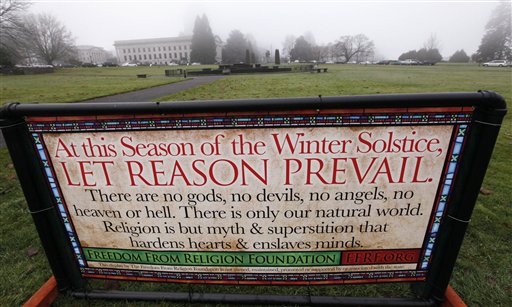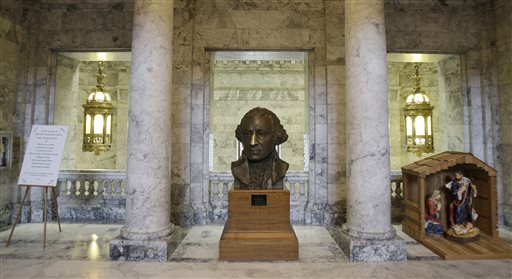Holidays are days that have been set aside to celebrate a cultural, religious, or national observance. Often these days have become special occasions — for example, Labor Day and Thanksgiving — when public schools and government offices are closed.
As the population of the United States has become culturally and religiously diverse, the observance of religious holidays has caused controversy in the workplace, in schools, and in public places. The conflicts arise from questions concerning the free exercise and establishment of religion clauses of the First Amendment.
Does government recognition of religious holidays violate First Amendment?
If a government refuses to recognize religious holidays for fear of establishing or favoring a religion, does that refusal infringe on an individual’s right to the free exercise of religion? If it does recognize such holidays, is it violating the establishment clause? Several important cases dealing with these questions have been heard in the courts.
When Indiana’s practice of giving state employees Good Friday off with pay was challenged, the Seventh Circuit Court of Appeals, in Bridenbaugh v. O’Bannon (7th Cir. 1999), stated that a government may give employees a religious holiday as a paid vacation day, but it can do so only if it can provide a legitimate secular purpose for choosing a particular day. Bridenbaugh argued that Indiana’s practice, a law since 1941, violated the separation of church and state.

This July 1, 2009 photo shows Moneeb Hassan, 17, posing for a picture in front of his high school in New York. Hassan is one of thousands of Muslim students in the city who had to perform a balancing act between their academic and religious obligations during his holidays. But the nation’s largest school district had not at that time sanctioned official Muslim holidays. Some school districts have started to recognize Muslim holidays, and allowed days off. (AP Photo/Seth Wenig, used with permission from the Associated Press)
Jewish lawyer challenged Christmas Day as a legal public holiday
In 1998, Richard Ganulin, a Jewish lawyer, filed suit against the U.S. government alleging that the law making Christmas day a legal public holiday violated the establishment clause of the First Amendment.
Ganulin based his complaint on the fact that Christmas is a Christian holiday when Christians celebrate the birth of Jesus Christ. In Ganulin v. United States (S.D. Ohio 1999), a federal district judge in Cincinnati granted a motion to dismiss the case. Ganulin appealed to the Sixth Circuit Court of Appeals. In 2000 the Court of Appeals affirmed the district court’s decision in an unpublished decision and dismissed the lawsuit. Ganulin appealed the case to the Supreme Court, which denied certiorari in 2001, leaving in place the Sixth Circuit’s decision affirming the holiday’s constitutionality.
Since Ganulin filed his lawsuit, two major appeals to court decisions have been handed down regarding official holidays.
In Granzeier v. Middleton (6th Cir. 1999), the Sixth Circuit Court of Appeals held that closing a county’s courts and administrative offices on Good Friday did not violate the Constitution. The Fourth Circuit Court of Appeals also upheld a Good Friday holiday in Maryland in Koenick v. Felton (4th Cir. 1999).
Public schools can celebrate holidays with both secular and religious significance
Supreme Court decisions on religion in public schools have stated that Christmas, Hanukkah, and other religious holidays may be observed in a secular manner. Teachers may teach objectively about the religious components of holidays when they deem the religious elements appropriate as part of the secular instruction.
Public schools are limited to celebrating holidays that have both secular and religious significance. Thus, for example, it would not be appropriate to celebrate Easter in the public schools, but it would be appropriate to recognize Thanksgiving.

A display that declares “There are no gods” sits on the Capitol campus in 2011 in Olympia, Washington. A Nativity scene was set up a couple of hundred feet away from the non-religious display. The religious holiday displays that have previously competed for attention on the state’s Capitol campus are now co-existing peacefully. State officials have been grappling in recent years with how to balance the First Amendment issues of religion and free speech. (AP Photo/Elaine Thompson, used with permission from the Associated Press)
Holiday displays on public property at times impermissibly endorse religion
In Lynch v Donnelly (1984), the Supreme Court, in a 5-4 decision, held that the City of Pawtucket, Rhode Island, could have a nativity scene on public property because it also displayed secular Christmas symbols, such as a Santa’s house and a Christmas tree.
The Court found that the display merely depicted the historical origins of the holiday and had “legitimate secular purposes.” In the minds of the Court’s majority, the crèche served the legitimate secular purpose of symbolically depicting the historical origins of the Christmas holiday.
Five years later, in County of Allegheny v. American Civil Liberties Union (1989), the ACLU challenged two public sponsored holiday displays in Pittsburgh, Pennsylvania, as state endorsement of religion.
The first display involved a Christian nativity scene inside Allegheny County’s courthouse. The second display was a large Hanukkah menorah, erected each year by the Chabad Jewish organization, outside the City-County Building.
In a 5-4 decision, the Court held that the crèche inside the courthouse unmistakably endorsed Christianity in violation of the establishment clause. By prominently displaying the words “Glory to God for the birth of Jesus Christ,” the county sent the message that it supported and promoted Christianity. The Court also held, however, that not all religious celebrations on government property violated the establishment clause; in context, the menorah simply emphasized the diversity of the season.
People who feel strongly that it is their right to place religious displays on public property are looking for ways to display religious symbols so that they pass the constitutional tests. And governments at all levels are becoming more sensitive to potential conflicts and the consequences of those conflicts.
This article was originally published in 2009. J. Mark Alcorn is a high school and college history instructor in Minnesota. Hana M. Ryman is a Middle School Humanities Educator in Orlando, Florida.

